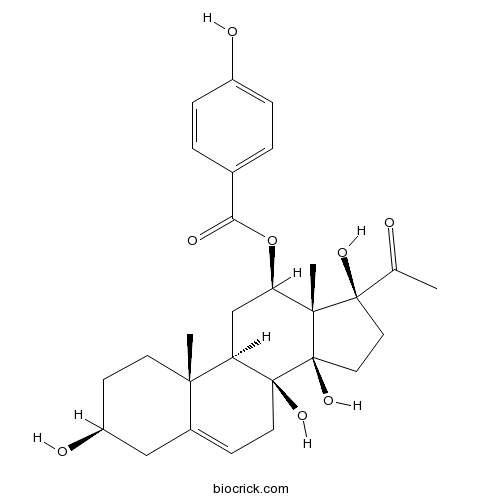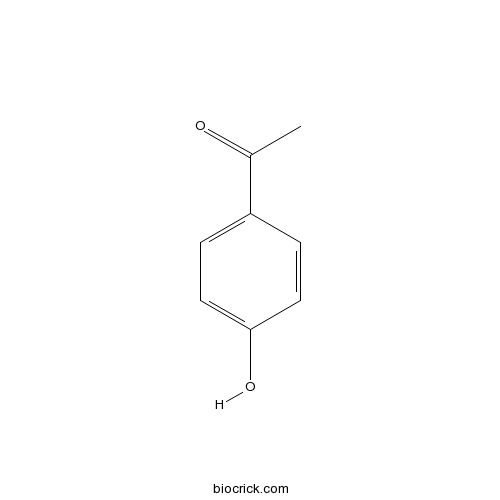Cynanchum otophyllum
Cynanchum otophyllum
1. The products in our compound library are selected from thousands of unique natural products; 2. It has the characteristics of diverse structure, diverse sources and wide coverage of activities; 3. Provide information on the activity of products from major journals, patents and research reports around the world, providing theoretical direction and research basis for further research and screening; 4. Free combination according to the type, source, target and disease of natural product; 5. The compound powder is placed in a covered tube and then discharged into a 10 x 10 cryostat; 6. Transport in ice pack or dry ice pack. Please store it at -20 °C as soon as possible after receiving the product, and use it as soon as possible after opening.
Natural products/compounds from Cynanchum otophyllum
- Cat.No. Product Name CAS Number COA
-
BCN4389
Qingyangshengenin84745-94-8
Instructions

-
BCN4544
4'-Hydroxyacetophenone99-93-4
Instructions

C21 steroidal glycosides with cytotoxic activities from Cynanchum otophyllum.[Pubmed: 29625825]
None
Characterization and milk coagulating properties of Cynanchum otophyllum Schneid. proteases.[Pubmed: 29428763]
The herbaceous plant Cynanchum otophyllum Schneid. is widely used as a milk coagulant to make a Chinese traditional milk product, milk cake. However, the milk-clotting compounds and their mechanism remain unclear. In this study, crude proteases were extracted from the dried leaves of Cynanchum otophyllum Schneid. using citric acid-phosphate buffer and then partially purified by weak anion exchange chromatography. Two proteases, QA and QC, with molecular weights of 14 and 27 kDa, respectively, were shown to exhibit milk-clotting activity. A study of the effects of pH and temperature on the milk-clotting activity and proteolytic activity of the proteases showed that they exhibited good pH stability from pH 5.5 to 7.5 and good thermal stability at temperatures from 50 to 70°C. The QA and QC were the cysteine proteases, able to hydrolyze β-casein and κ-casein completely, and α-casein partially. The cleavage site on κ-casein determined by Orbitrap (Thermo Fisher Scientific, San Jose, CA) analysis showed that QA and QC could cleave κ-casein at Ser132-Thr133. Overall, the results suggest that the Cynanchum otophyllum Schneid. proteases are a promising milk-clotting enzyme that could be used for manufacturing milk cake and cheese.
Otophylloside B Protects Against Aβ Toxicity in Caenorhabditis elegans Models of Alzheimer's Disease.[Pubmed: 28194725]
Alzheimer's disease (AD) is a major public health concern worldwide and the few drugs currently available only treat the symptoms. Hence, there is a strong need to find more effective anti-AD agents. Cynanchum otophyllum is a traditional Chinese medicine for treating epilepsy, and otophylloside B (Ot B), isolated from C. otophyllum, is the essential active component. Having previously identified anti-aging effects of Ot B, we evaluated Ot B for AD prevention in C. elegans models of AD and found that Ot B extended lifespan, increased heat stress-resistance, delayed body paralysis, and increased the chemotaxis response. Collectively, these results indicated that Ot B protects against Aβ toxicity. Further mechanistic studies revealed that Ot B decreased Aβ deposition by decreasing the expression of Aβ at the mRNA level. Genetic analyses showed that Ot B mediated its effects by increasing the activity of heat shock transcription factor (HSF) by upregulating the expression of hsf-1 and its target genes, hsp-12.6, hsp-16.2 and hsp-70. Ot B also increased the expression of sod-3 by partially activating DAF-16, while SKN-1 was not essential in Ot B-mediated protection against Aβ toxicity.
Protective Effects of Otophylloside N on Pentylenetetrazol-Induced Neuronal Injury In vitro and In vivo.[Pubmed: 27504096]
Approximately 30% of epileptic patients worldwide are medically unable to control their seizures. In addition, repeated epileptic seizures generally lead to neural damage. Pentylenetetrazol (PTZ) is a clinical circulatory and respiratory stimulant that is experimentally used to mimic epileptic convulsion in epilepsy research. Here, we systematically explore the neuroprotective effects of a pure compound isolated from Cynanchum otophyllum Schneid (Qingyangshen), Otophylloside N (OtoN), against PTZ-induced neuronal injury. We used three models: in vitro primary cortical neurons, in vivo mice, and in vivo zebrafish. Our results revealed that OtoN treatment may attenuate PTZ-induced morphology changes, cell death, LDH efflux in embryonic neuronal cells of C57BL/6J mice, and convulsive behavior in zebrafish. Additionally, our Western blot and RT-PCR results demonstrated that OtoN may attenuate PTZ-induced apoptosis and neuronal activation in neuronal cells, mice, and zebrafish. OtoN may reduce PTZ-induced cleavage of poly ADP-ribose polymerase and upregulation of the Bax/Bcl-2 ratio and decrease the expression level of c-Fos. This study is the first investigation of the neuroprotective effects of OtoN, which might be developed as a novel antiepileptic drug.
Pregnane glycosides from the antidepressant active fraction of cultivated Cynanchum otophyllum.[Pubmed: 26944766]
Based on the bioactive screening results, four new pregnane glycosides, namely cynanotophyllosides A-D (1-4) were isolated from the anti-depressant active fraction of cultivated Cynanchum otophyllum, along with thirteen known compounds (5-17). The new compounds were characterized as qingyangshengenin 3-O-β-D-glucopyranosyl-(1→4)-β-D-cymaropyranosyl-(1→4)-β-D-oleandropyranosyl-(1→4)-β-D-cymaropyranosyl-(1→4)-β-D-cymaropyranoside (1), qingyangshengenin-3-O-β-D-glucopyranosyl-(1→4)-β-D-glucopyranosyl-(1→4)-β-D-oleandropyranosyl-(1→4)-β-D-cymaropyranosyl-(1→4)-α-L-cymaropyranosyl-(1→4)-β-D-cymaropyranoside (2), caudatin-3-O-β-D-glucopyranosyl-(1→4)-β-D-thevetopyranosyl-(1→4)-β-D-cymaropyranosyl-(1→4)-β-D-digitoxopyranoside (3) caudatin-3-O-β-D-glucopyranosyl -(1→4)-β-D-thevetopyranosyl-(1→4)-β-D-cymaropyranosyl-(1→4)-β-D-cymaropyranoside (4), by detailed spectroscopic analysis and acidic hydrolysis.
[Chemical constituents of ethnic medicine Cynanchum otophyllum].[Pubmed: 28845649]
In order to isolate and purify the reference compounds and improve the quality standard of ethnic medicine of Radix of Cynanchum otophyllum, the ethanol extracts were isolated by column chromatography onsilica gel, C₁₈ reverse-phase silica gel, and semi-preparative HPLC. Twelve compounds were isolated and their structures were elucidated as 2,4-dihydroxy-6-methoxyphenylethanone(1), 4,6-dihydroxy-2-methoxyphenylethanone(2), p-hydroxyacetophenone(3), baishouwubenzophenone(4), 2,4-dihydroxyacetophenone(5), 2,5-dihydroxyacetophenone(6), otophylloside A(7),otophylloside B(8), caudatin-3-O-β-D-cymaropyranosyl-(1→4)-β-D-digitoxopyranoside(9),caudatin-3-O-β-D-glucopyranosyl-(1→4)-β-D-oleandropyranosyl-(1→4)-β-D-cymaropyranosyl-(1→4)-β-D-digitoxopyranoside(10),qingyangshengenin-3-O-β-D-oleandropyranosyl-(1→4)-β-D-cymaropyranoside(11),caudatin-3-O-β-D-oleandropyranosyl-(1→4)-β-D-cymaropyranosyl-(1→4)-β-D-cymaropyranoside(12) on the basis of spectral analysis. Compounds 1 and 2 were isolated from the genus Cynanchum for the first time, and compounds 3-4, 9-12 were obtained from this plant for the first time.These compounds are main active components of Radix of C.otophyllum and can be used as reference substances for the quality control of this ethnic medicine.
Cytotoxicity of pregnane glycosides of Cynanchum otophyllum.[Pubmed: 26297951]
Fourteen new pregnane glycosides, including nine caudatin glycosides (1-9), three qinyangshengenin glycosides (10-12), one kidjoranin glycosides (13) and one gagaminin glycosides (14), along with twelve known analogs (15-26) were isolated from roots of Cynanchum otophyllum Schneid. Their structures were deduced by detailed analysis of 1D and 2D NMR spectra, as well as HRESIMS. In this study, all pregnane glycosides obtained (1-26) were evaluated for their cytotoxic activities using three cancer cell lines (HepG2, Hela, U251). As results, except 6 and 10, other twenty-four pregnane glycosides showed cytotoxicities at different degrees against three cell lines.
Bioactive C21 Steroidal Glycosides from the Roots of Cynanchum otophyllum That Suppress the Seizure-like Locomotor Activity of Zebrafish Caused by Pentylenetetrazole.[Pubmed: 26135914]
Six new C21 steroidal glycosides, cynotophyllosides A-F (1-6), together with 16 known compounds, were isolated from the roots of Cynanchum otophyllum. The structures of the new compounds were elucidated by spectroscopic analysis and chemical methods. The three major components, otophylloside F (15), otophylloside B (17), and rostratamine 3-O-β-D-oleandropyranosyl-(1→4)-β-D-cymaropyranosyl-(1→4)-β-D-cymaropyranoside (18), suppressed the seizure-like locomotor activity caused by pentylenetetrazole in zebrafish. Preliminary structure-activity relation studies revealed that a pregnene skeleton with a C-12 ester group (ikemaoyl > cinnamoyl > hydroxy > p-hydroxybenzoyl) and a C-3 sugar chain consisting of three 2,6-dideoxysaccharide units is essential for this suppressive activity.
The Lifespan-Promoting Effect of Otophylloside B in Caenorhabditis elegans.[Pubmed: 26112394]
Aging is the major risk factor for many human diseases and degeneration. Thus, clinically effective medicine could delay the process of aging and aging-related diseases are desperately wanted. In traditional Chinese medicine (TCM), some were claimed to slow down aging. Qingyangshen (Cynanchum otophyllum schneid) is such a TCM. Here, we assayed the longevity effect of compound Otophylloside B (Ot B), a C-21 steroidal glycoside isolated from Qingyangshen, in Caenorhabditis elegans, which is a popular model for aging research. Our results showed that Ot B could modestly extend the lifespan of C. elegans, delay the age-related decline of body movement and improve the stress resistance. Further investigating the molecular mechanism of lifespan extension effect revealed that Ot B could activate the FOXO transcription factor DAF-16. Ot B could not further extend the lifespan of long-lived mutant of insulin/IGF-1-like receptor (daf-2). In addition, Ot B also requires SIR-2.1 and CLK-1 which is an enzyme in ubiquinone synthesis, for lifespan extension.
Antiepileptic C21 steroids from the roots of Cynanchum otophyllum.[Pubmed: 25579837]
In order to discover more natural products possessing potentially antiepileptic activities, three C21 steroids, including a new one, characterized as caudatin-3-O-β-D-cymaropyranosyl-(1 → 4)-β-D-cymaropyranosyl-(1 → 4)-β-D-cymaropyranoside (1), and two known analogs, otophylloside B (2) and caudatin-3-O-β-D-oleandropyranosyl-(1 → 4)-β-D-oleandropyranosyl-(1 → 4)-β-D-cymaropyranosyl-(1 → 4)-β-D-cymaropyranoside (3), were isolated from the chloroform extract of the roots of Cynanchum otophyllum and evaluated for their antiepileptic activities by pentylenetrazole (PTZ)-induced zebrafish larval locomotor assay. The results showed that all of them had marked activities of suppressing PTZ-induced seizure behaviors in larval zebrafish at the dose of 10 μg/ml.


